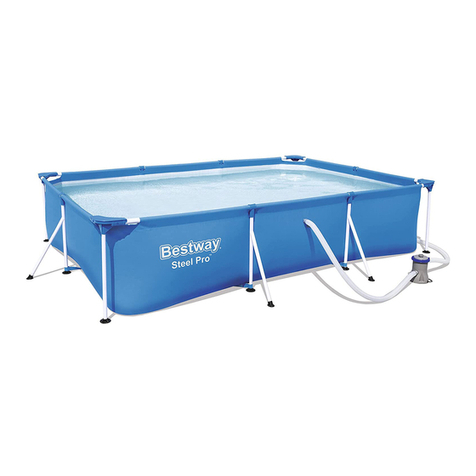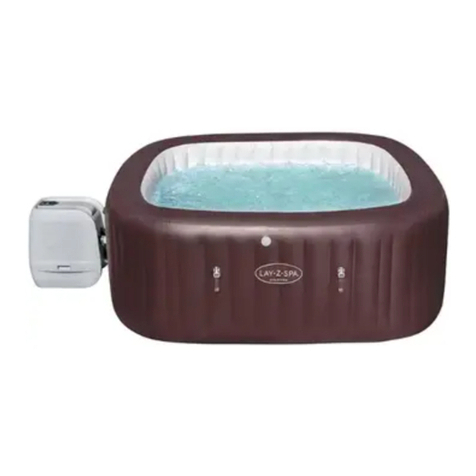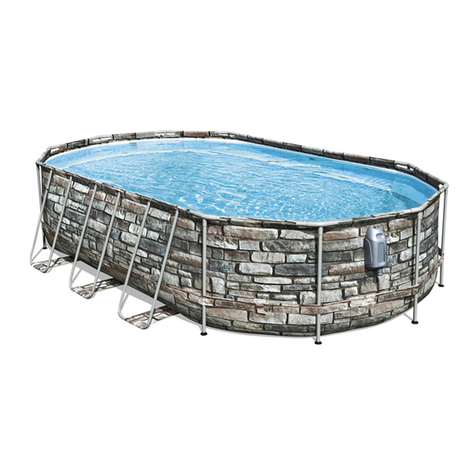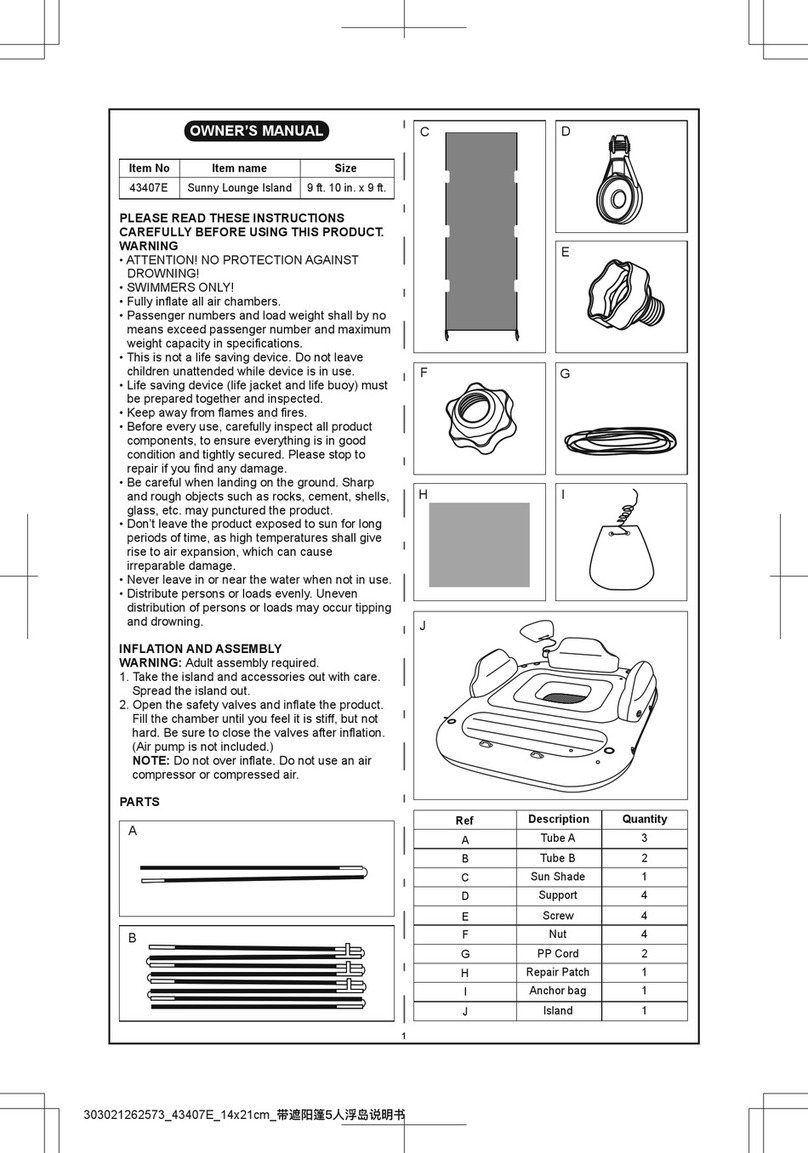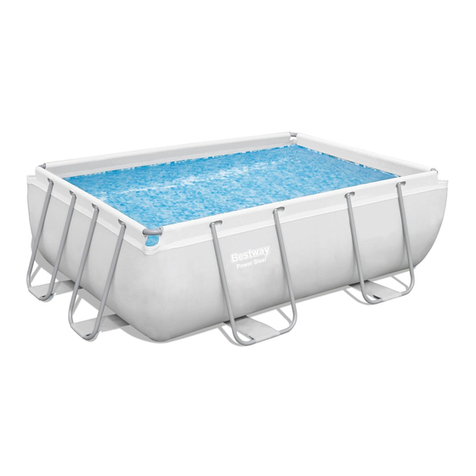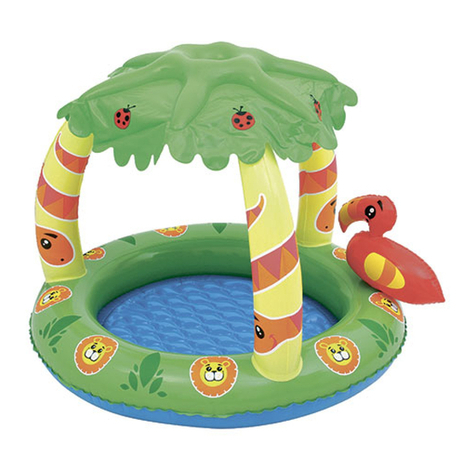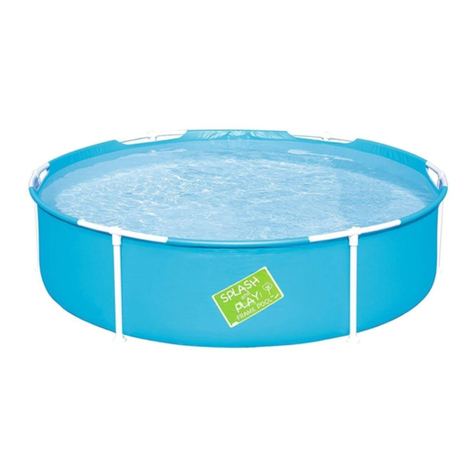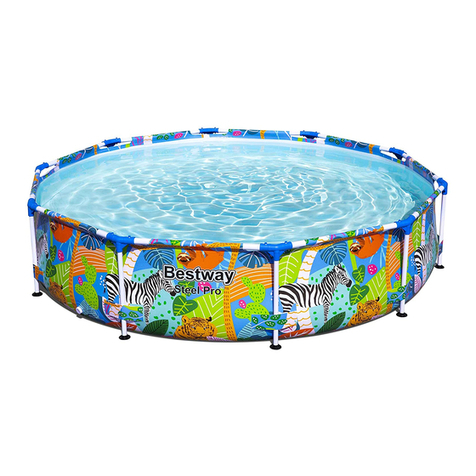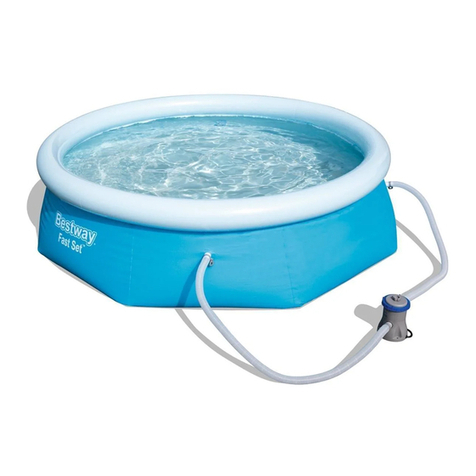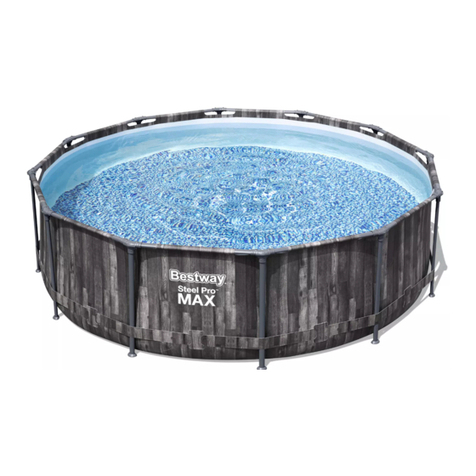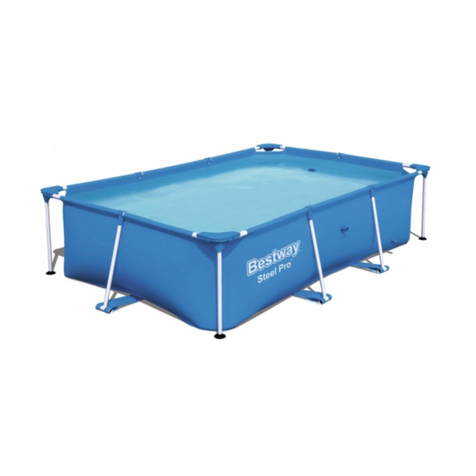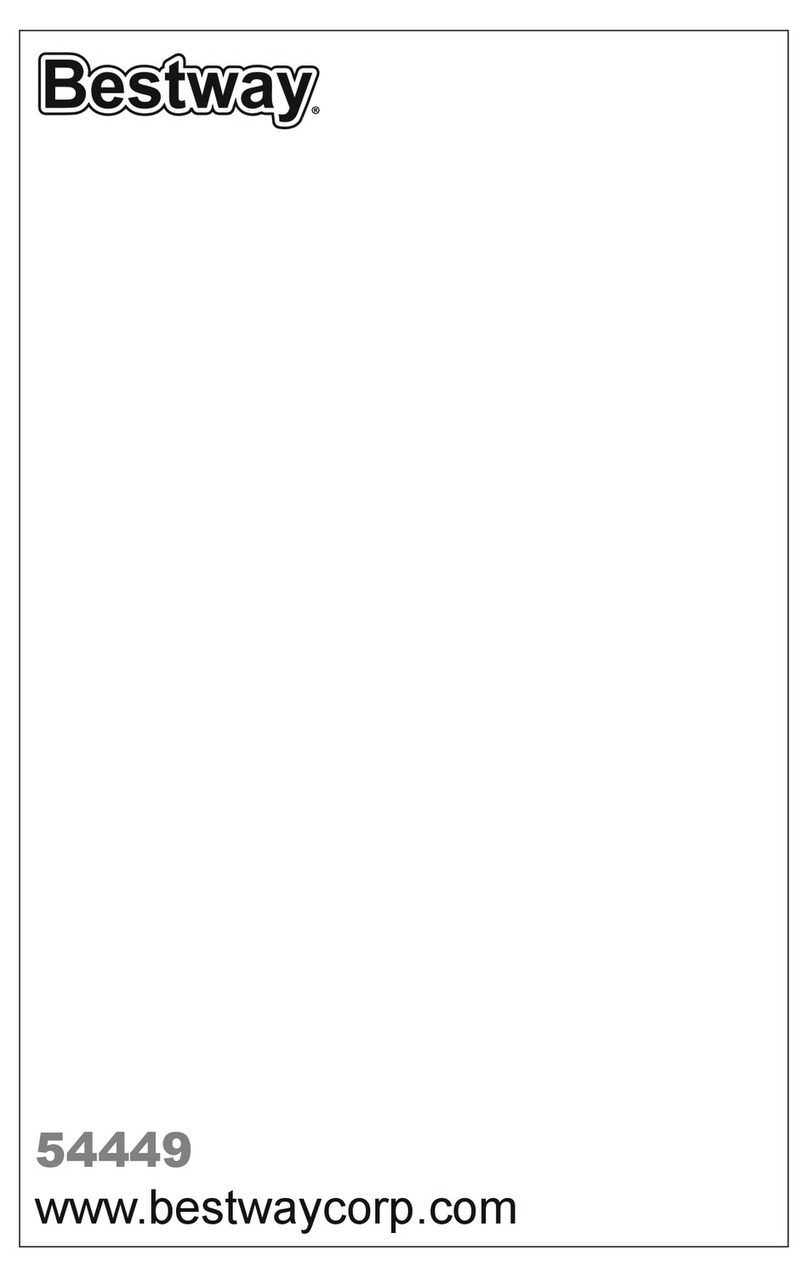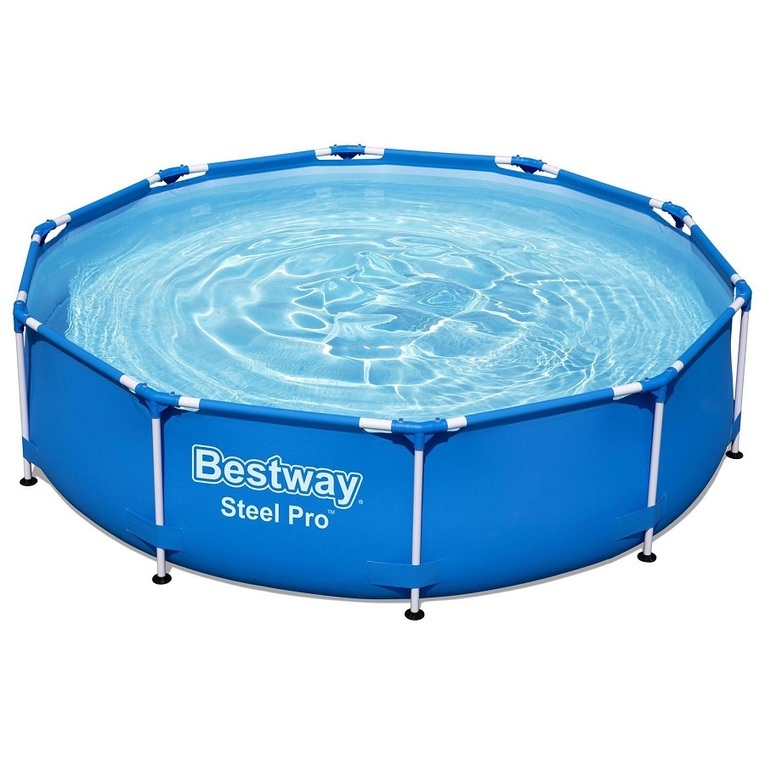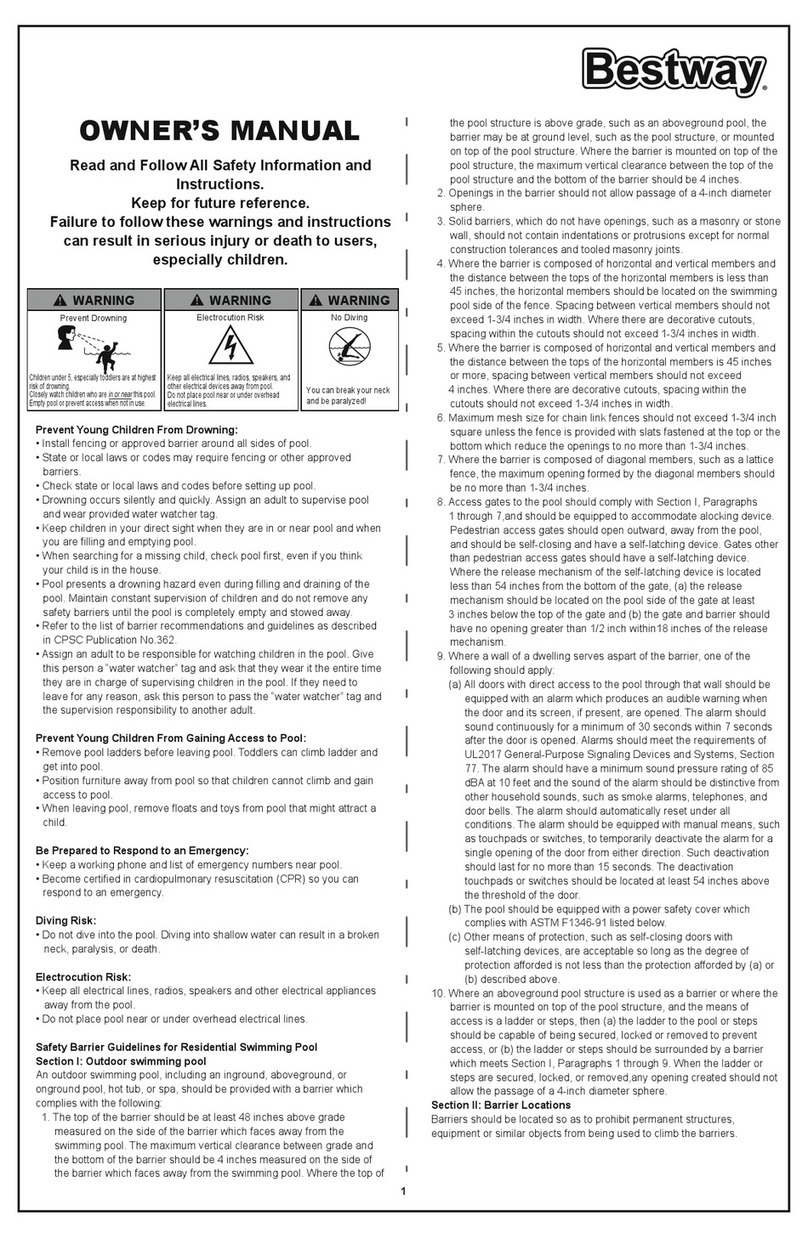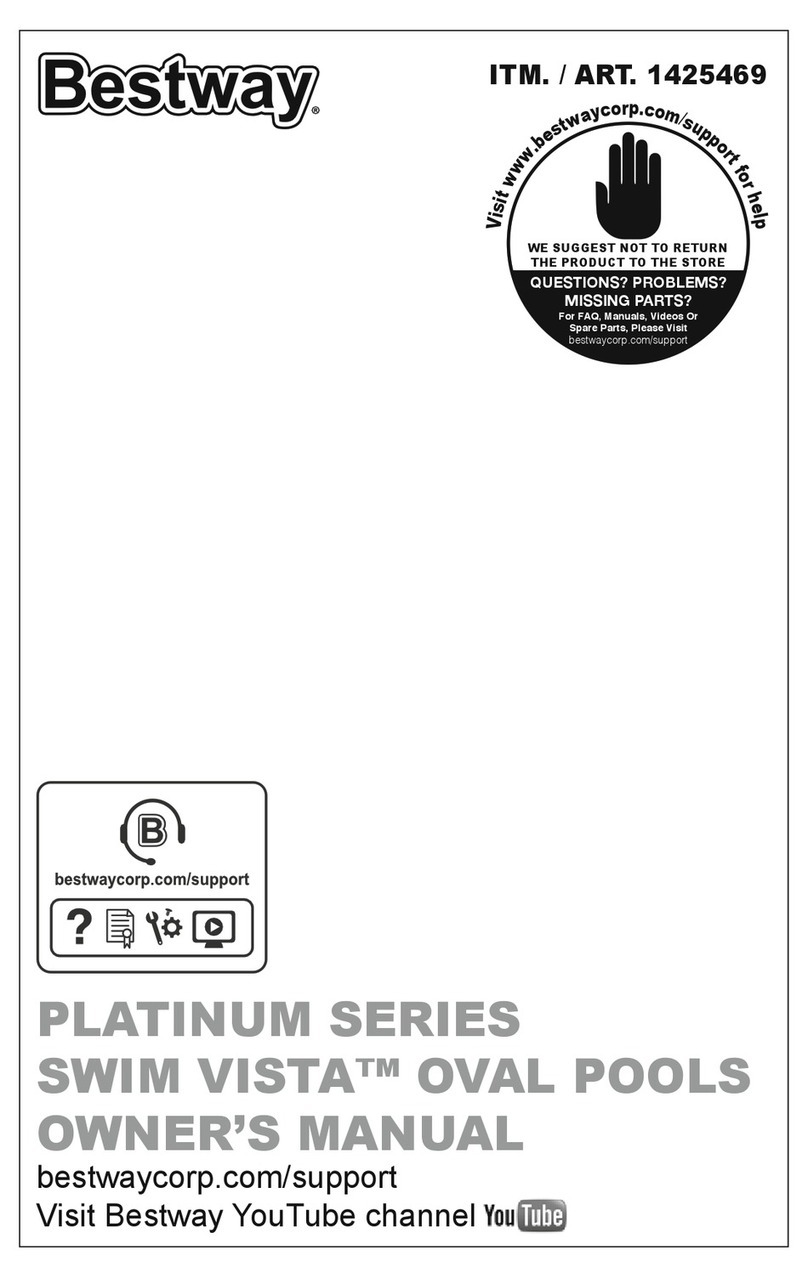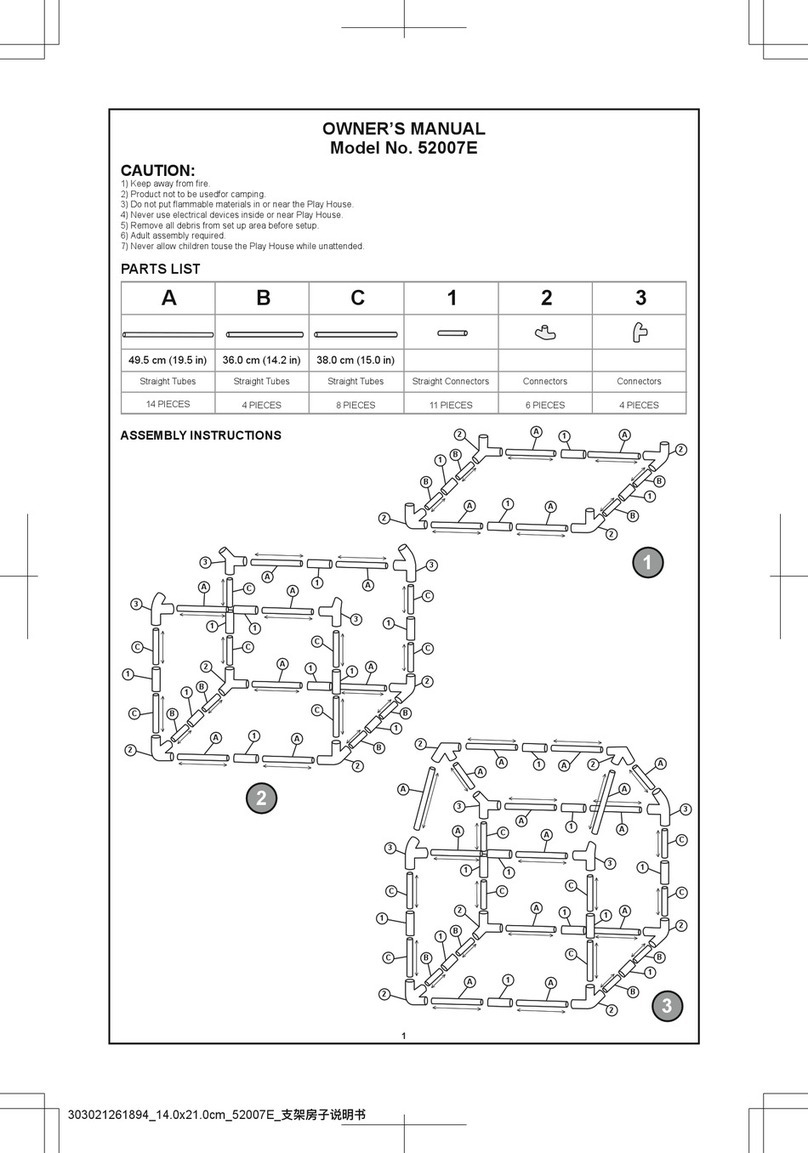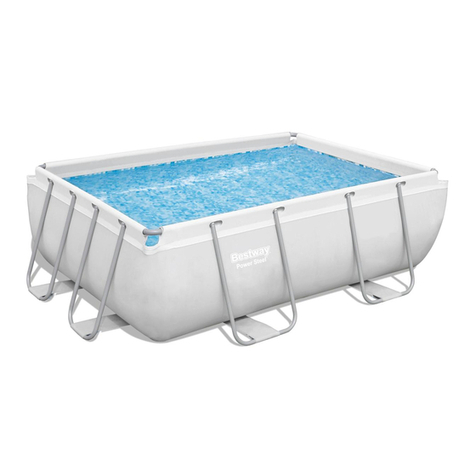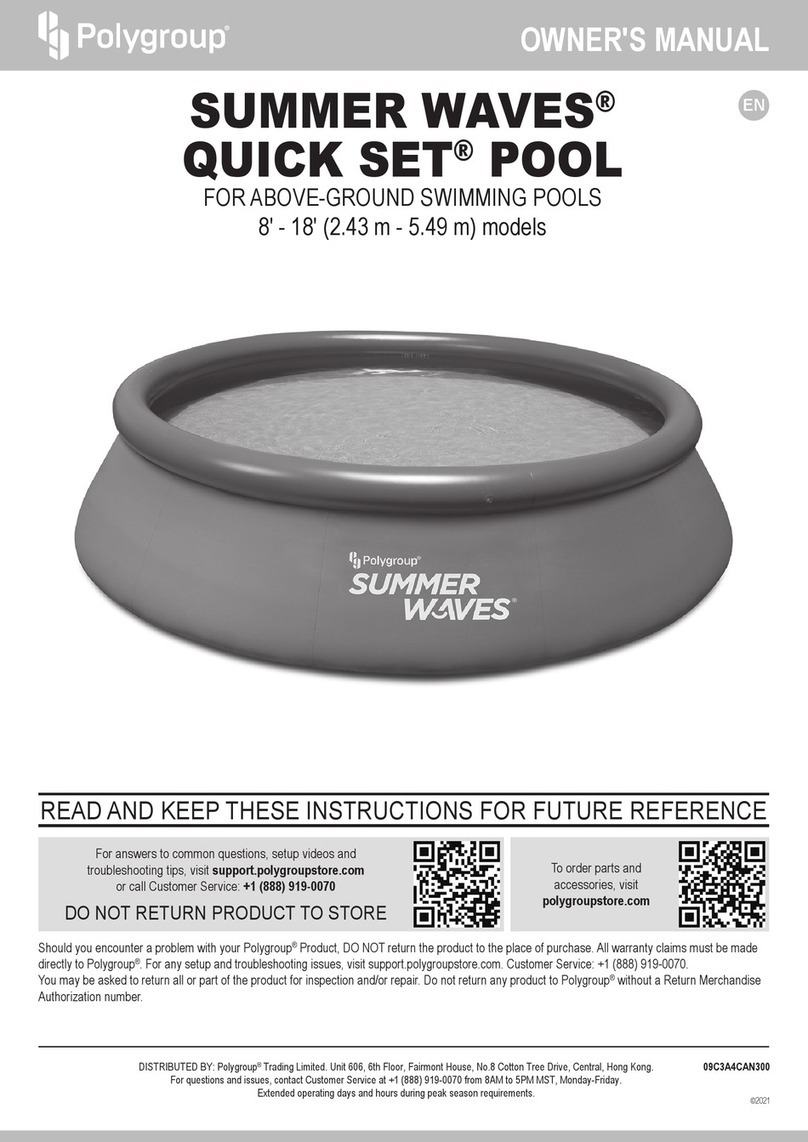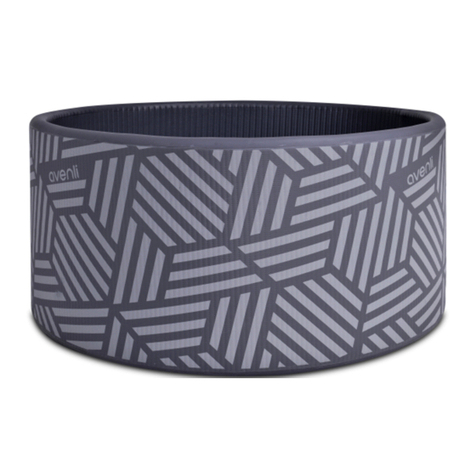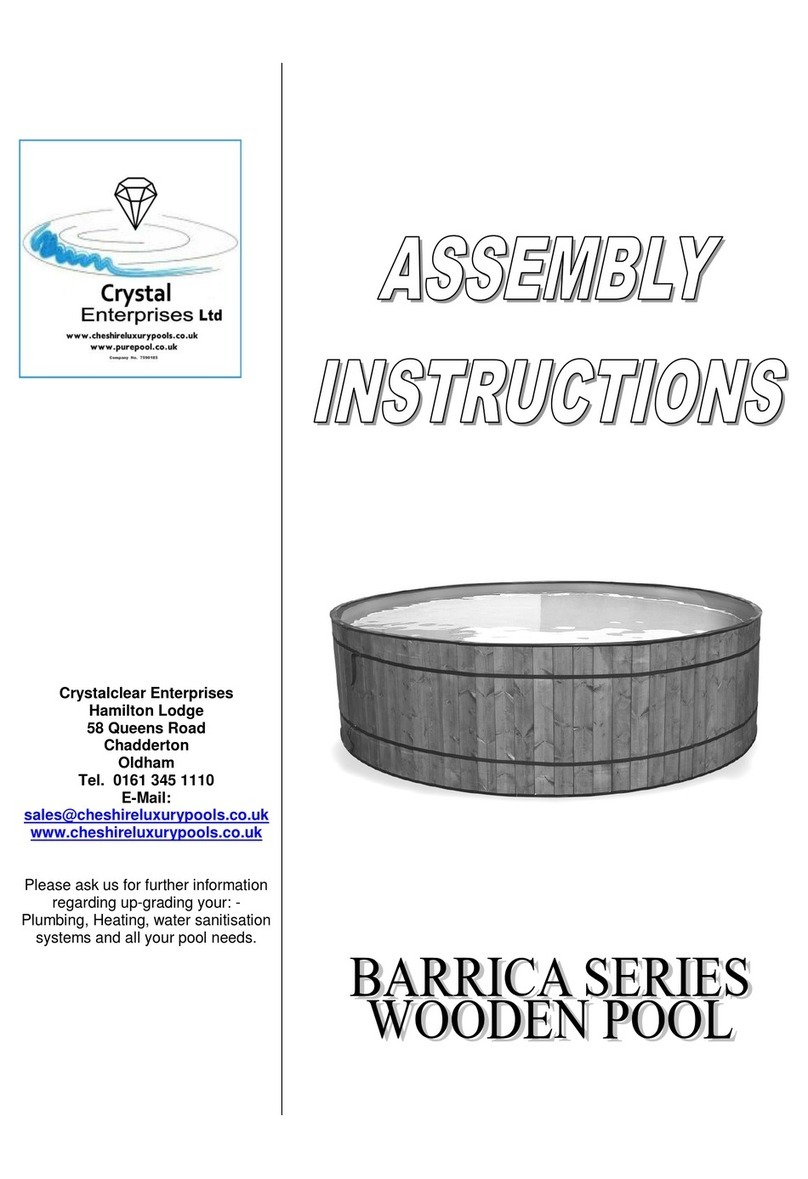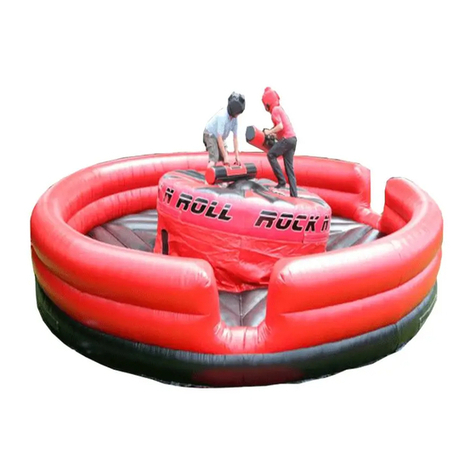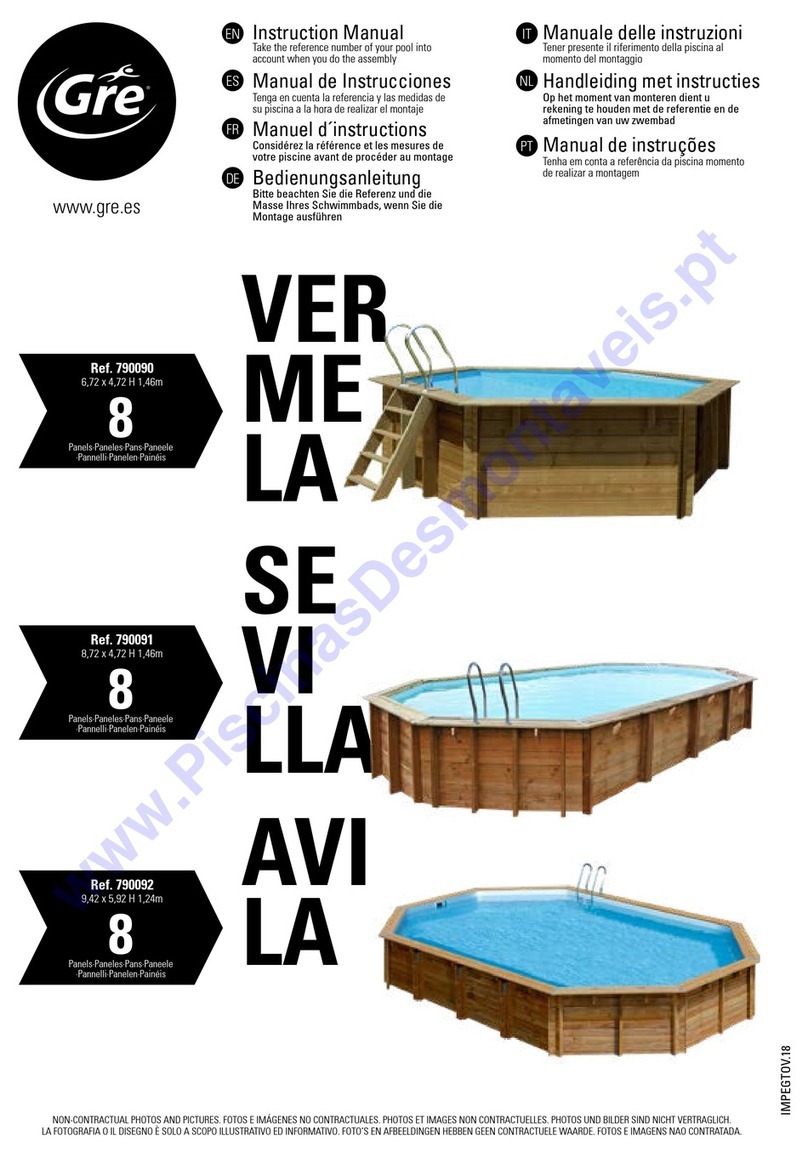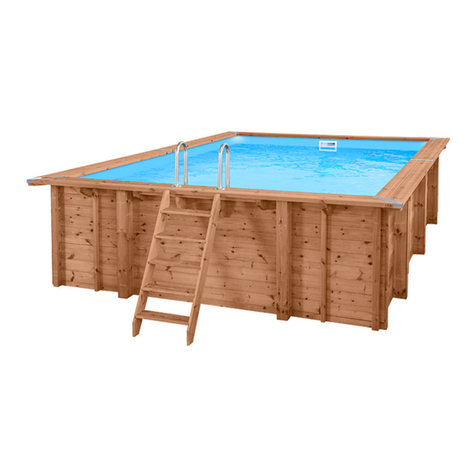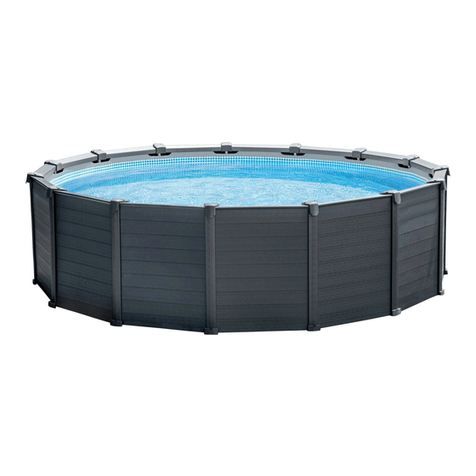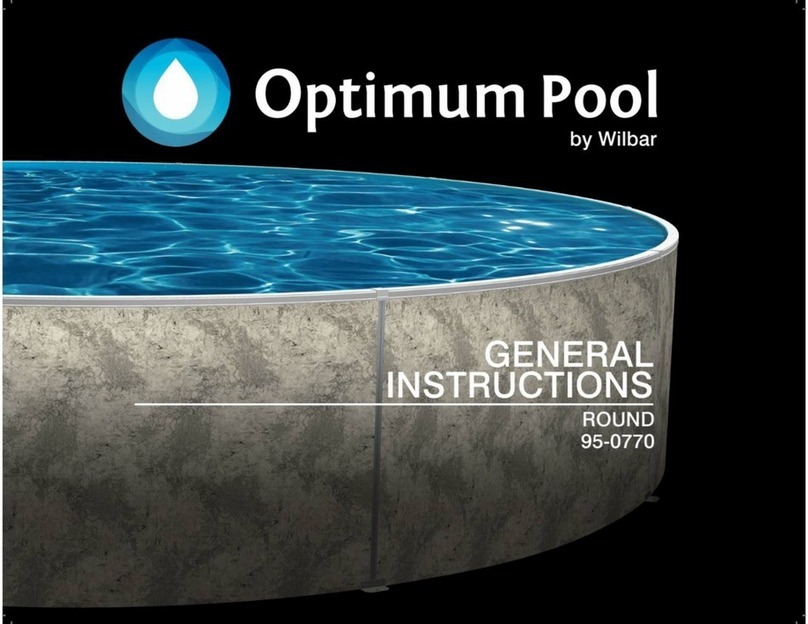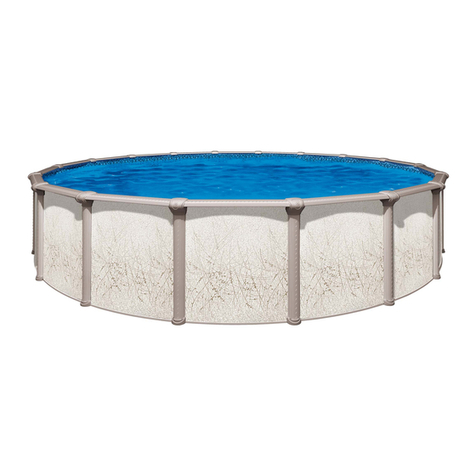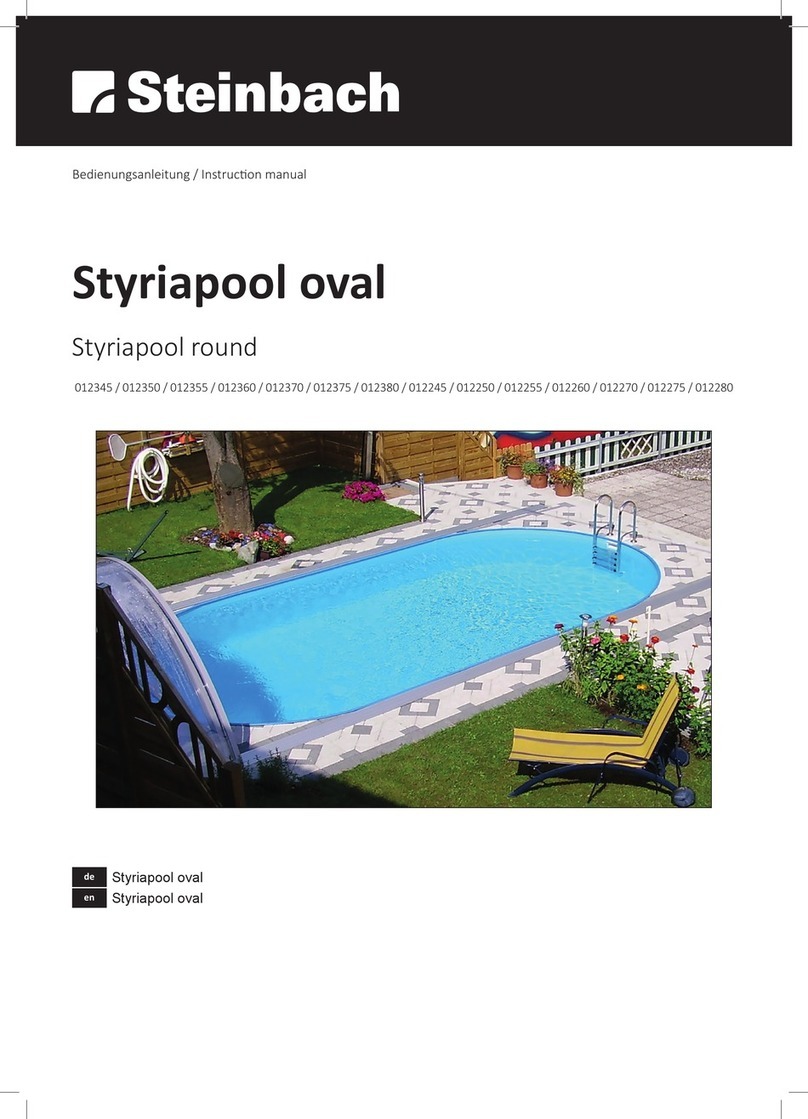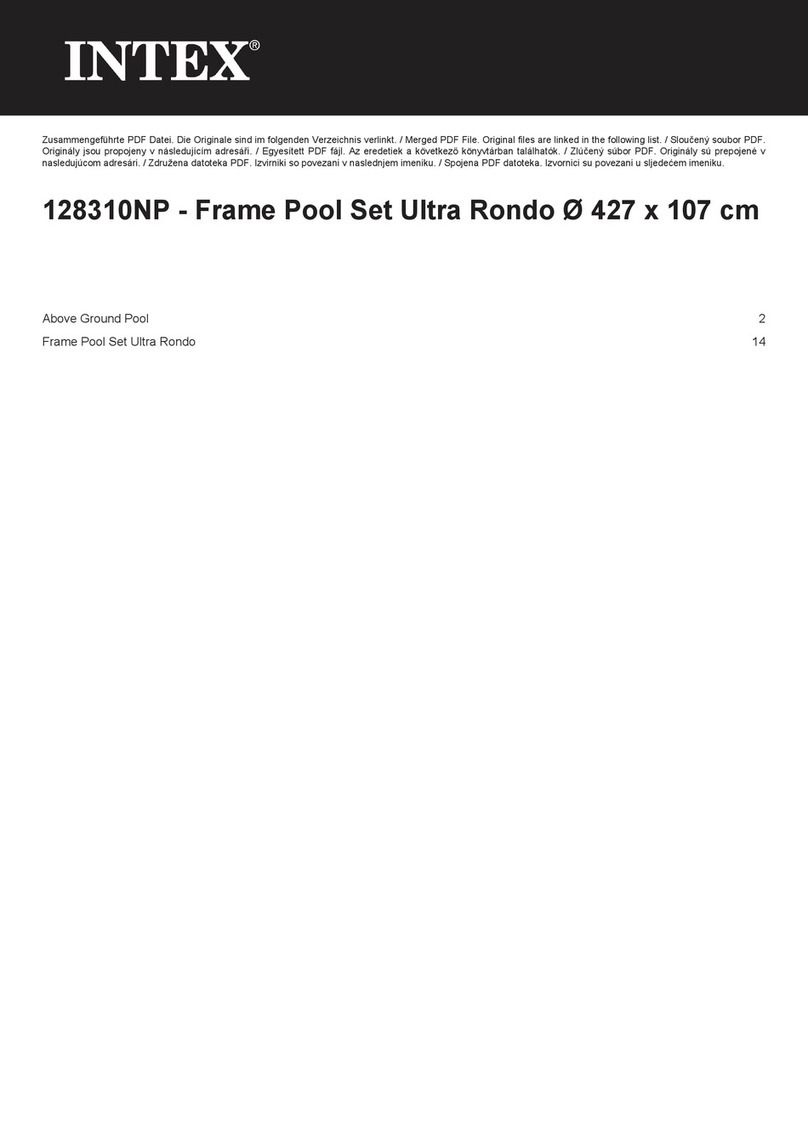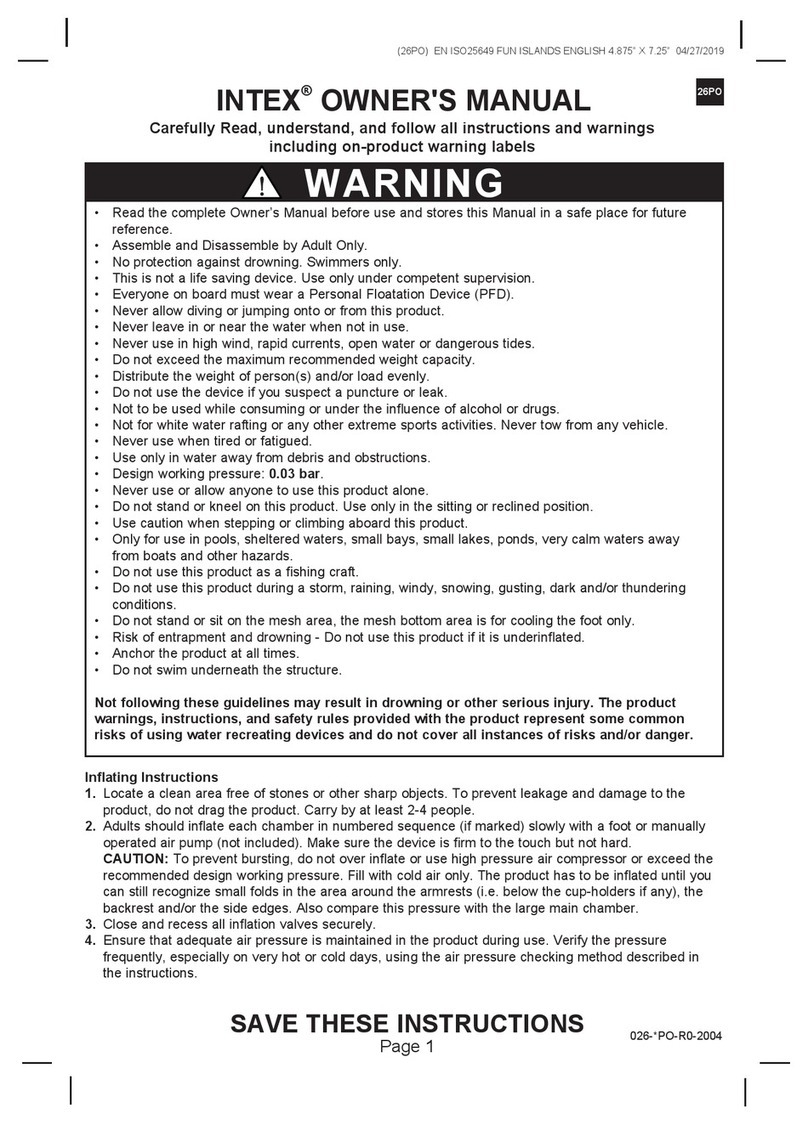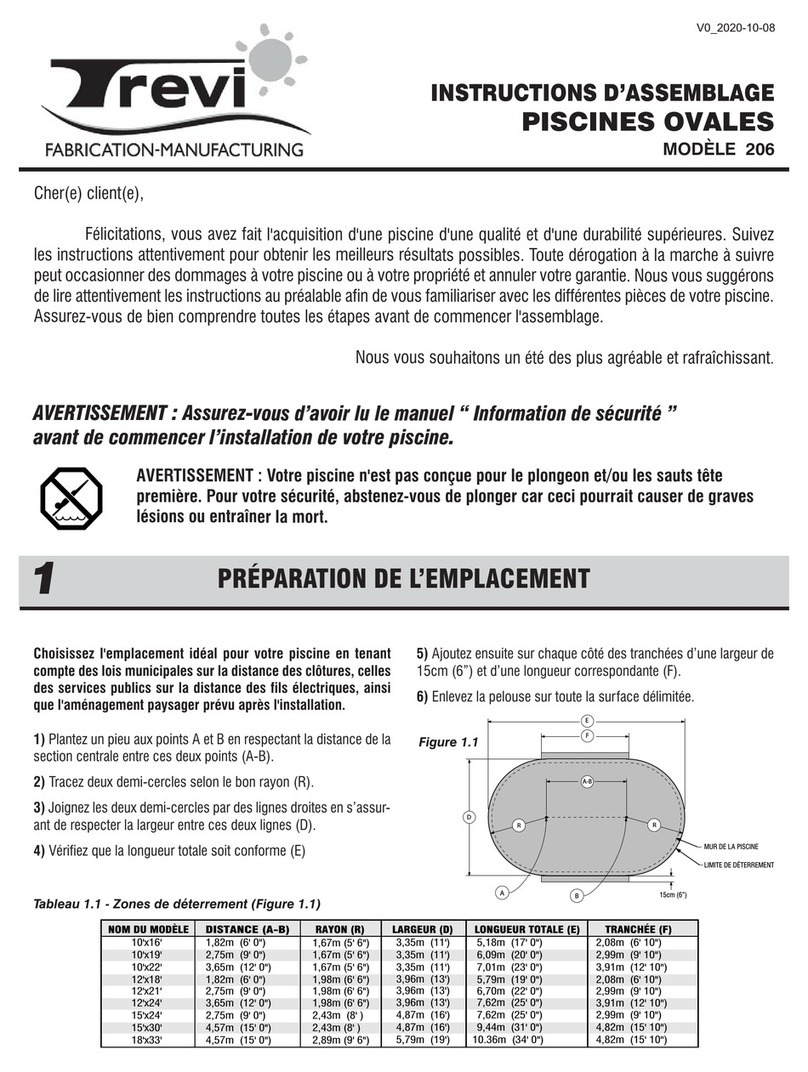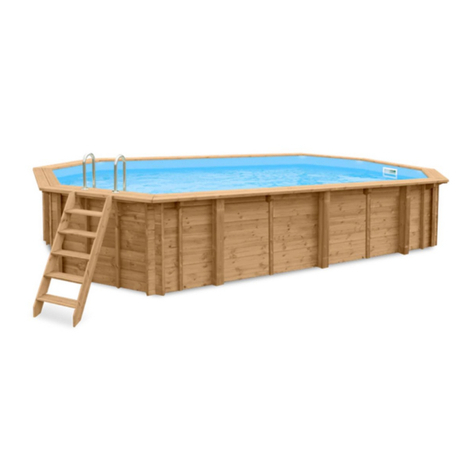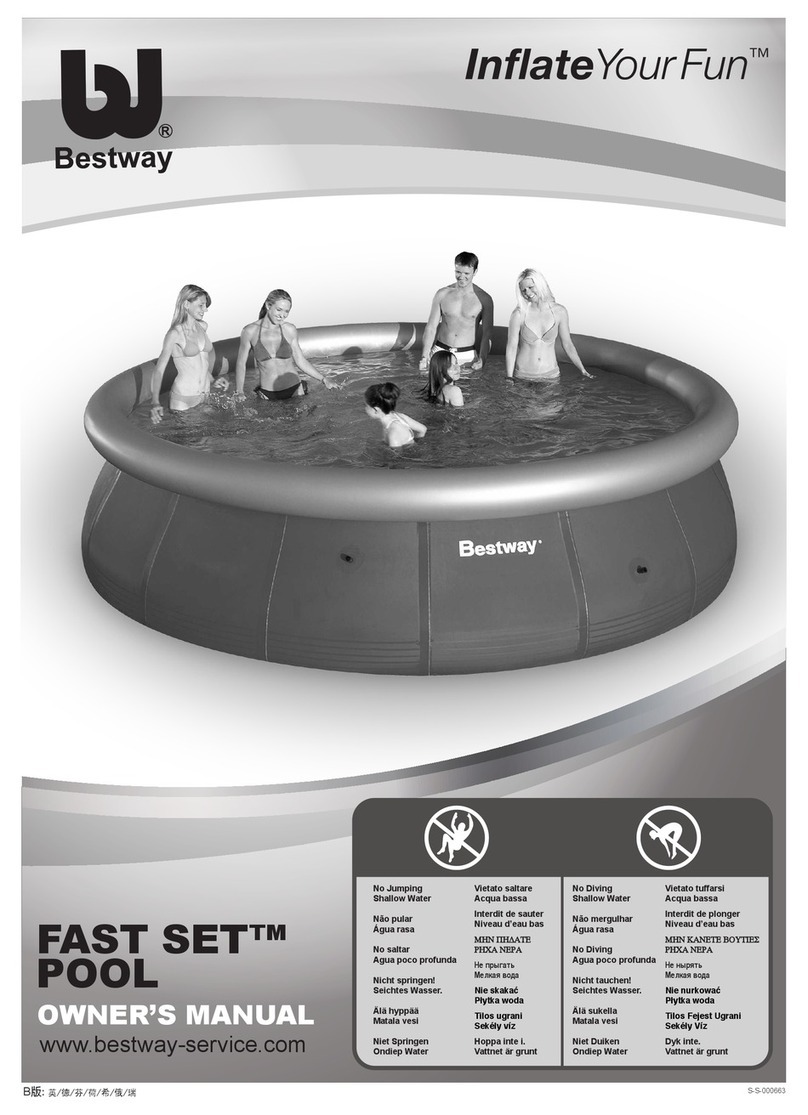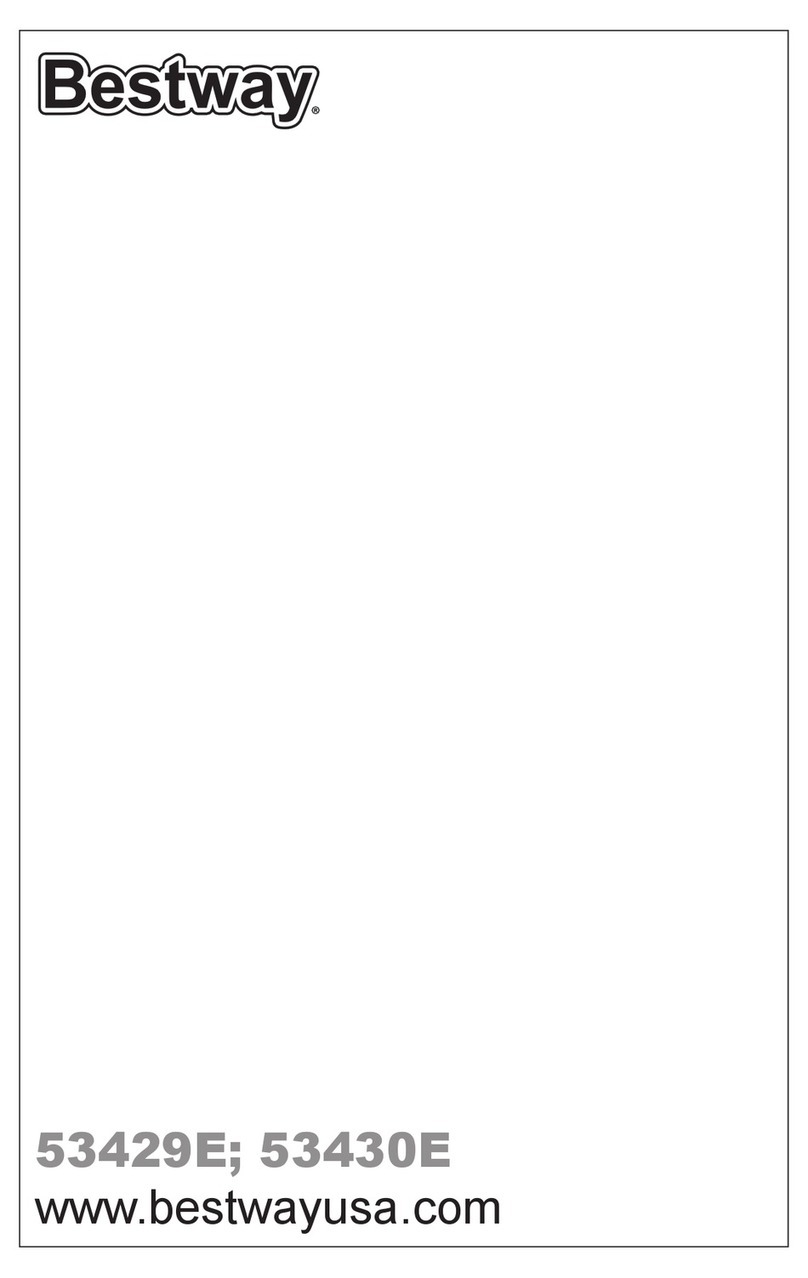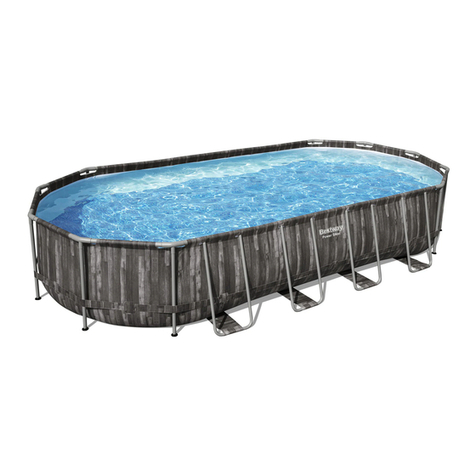
Prevent Young Children From Drowning:
• Install fencing or approved barrier around all sides of pool.
• State or local laws or codes may require fencing or other
approved barriers.
• Check state or local laws and codes before setting up
pool.
• Drowning occurs silently and quickly. Assign an adult to
supervise pool and wear provided water watcher tag.
• Keep children in your direct sight when they are in or near
pool and when you are filling and emptying pool.
• When searching for a missing child, check pool first, even
if you think your child is in the house.
• Pool presents a drowning hazard even during filling and
draining of the pool.
• Maintain constant supervision of children and do not
remove any safety barriers until the pool is completely
empty and stowed away.
• Refer to the list of barrier recommendations and
guidelines as described in CPSC Publication No.362.
• Assign an adult to be responsible for watching children in
the pool. Give this person a “water watcher” tag and ask
that they wear it the entire time they are in charge of
supervising children in the pool. If they need to leave for
any reason, ask this person to pass the “water watcher”
tag and the supervision responsibility to another adult.
Prevent Young Children From Gaining Access to Pool:
• Remove pool ladders before leaving pool. Toddlers can
climb ladder and get into pool.
• Position furniture away from pool so that children cannot
climb and gain access to pool.
• When leaving pool, remove floats and toys from pool that
might attract a child.
Be Prepared to Respond to an Emergency:
• Keep a working phone and list of emergency numbers
near pool.
• Become certified in cardiopulmonary resuscitation (CPR)
so you can respond to an emergency.
Diving Risk:
• Do not dive into the pool. Diving into shallow water can
result in a broken neck, paralysis, or death.
Electrocution Risk:
• Keep all electrical lines, radios, speakers and other
electrical appliances away from the pool.
• Do not place pool near or under overhead electrical lines.
Safety Barrier Guidelines for Residential Swimming
Pool
Section I: Outdoor swimming pool
An outdoor swimming pool, including an in-ground, above
ground, or on-ground pool, hot tub, or spa, should be
provided with a barrier which complies with the following:
1. The top of the barrier should be at least 48 inches
above grade measured on the side of the barrier which
faces away from the swimming pool. The maximum
vertical clearance between grade and the bottom of the
barrier should be 4 inches measured on the side of the
barrier which faces away from the swimming pool.
Where the top of the pool structure is above grade,
such as an above ground pool, the barrier may be at
ground level, such as the pool structure, or mounted on
top of the pool structure. Where the barrier is mounted
on top of the pool structure, the maximum vertical
clearance between the top of the pool structure and the
bottom of the barrier should be 4 inches.
2. Openings in the barrier should not allow passage of a
4-inch diameter sphere.
3. Solid barriers, which do not have openings, such as a
masonry or stone wall, should not contain indentations
or protrusions except for normal construction
tolerances and tooled masonry joints.
4. Where the barrier is composed of horizontal and
vertical members and the distance between the tops of
the horizontal members is less than 45 inches, the
horizontal members should be located on the
swimming pool side of the fence. Spacing between
vertical members should not exceed 1-3/4 inches in
width. Where there are decorative cutouts, spacing
within the cutouts should not exceed 1-3/4 inches in
width.
5. Where the barrier is composed of horizontal and
vertical members and the distance between the tops of
the horizontal members is 45 inches or more, spacing
between vertical members should not exceed 4 inches.
Where there are decorative cutouts, spacing within the
cutouts should not exceed 1-3/4 inches in width.
6. Maximum mesh size for chain link fences should not
exceed 1-3/4 inch square unless the fence is provided
with slats fastened at the top or the bottom which
reduce the openings to no more than 1-3/4 inches.
7. Where the barrier is composed of diagonal members,
such as a lattice fence, the maximum opening formed
by the diagonal members should be no more than 1-3/4
inches.
8. Access gates to the pool should comply with Section I,
Paragraphs 1 through 7, and should be equipped to
accommodate a locking device. Pedestrian access
gates should open outward, away from the pool, and
should be self-closing and have a self-latching device.
Gates other than pedestrian access gates should have
a self-latching device. Where the release mechanism of
the self-latching device is located less than 54 inches
from the bottom of the gate, (a) the release mechanism
should be located on the pool side of the gate at least 3
inches below the top of the gate and (b) the gate and
barrier should have no opening greater than 1/2 inch
within18 inches of the release mechanism.
9. Where a wall of a dwelling serves as part of the barrier,
one of the following should apply:
(a) All doors with direct access to the pool through that
wall should be equipped with an alarm which
produces an audible warning when the door and its
screen, if present, are opened. The alarm should
sound continuously for a minimum of 30 seconds
within 7 seconds after the door is opened. Alarms
should meet the requirements of UL2017
General-Purpose Signaling Devices and Systems,
Section 77. The alarm should have a minimum
sound pressure rating of 85 dBA at 10 feet and the
sound of the alarm should be distinctive from other
household sounds, such as smoke alarms,
telephones, and door bells. The alarm should
automatically reset under all conditions. The alarm
should be equipped with manual means, such as
Refer to the item name or number stated on the packaging.
Packaging must be read carefully and kept for future
reference.
PREPARATION
Installation of small swimming pool usually takes only 10
minutes with 1 people.
Recommendations regarding placement of the pool:
Do not install the pool on a slope or inclined surfaces, on
soft or loose soil conditions (such as sand or mud), or on
an elevated surface such as a deck, platform or balcony,
which may collapse under the weight of the filled pool.
• It is essential the pool is set up on solid, level ground. If
the pool is set up on uneven ground it can cause collapse
of the pool and flooding, causing serious personal injury
and/or damage to personal property.
• Do not set up on driveways, decks, platforms, gravel or
asphalt. Ground should be firm enough to withstand the
pressure of the water; mud, sand, soft / loose soil or tar
are not suitable.
• The ground must be cleared of all objects and debris
including stones and twigs.
• Check with your local city council for by-laws relating to
fencing, barriers, lighting and safety requirements and
ensure you comply with all laws.
POOL MAINTENANCE
WARNING: If you do not adhere to the maintenance
PRODUCT DESCRIPTION
Item
52565E; 98792E
Part
• Pool
• Repair patch
52571E • Splash pad
• Repair patch
303021292090
©2022 Bestway Inflatables & Material Corp.
All rights reserved
Trademarks used in some countries under license from Bestway Inflatables & Material Corp., Shanghai, China
Exported by Bestway (Hong Kong) International Ltd./Bestway Enterprise Company Limited
Suite 713, 7/Floor, East Wing, Tsim Sha Tsui Centre, 66 Mody Road, Kowloon, Hong Kong
Distributed in North America by Bestway (USA) Inc., 3435 S. McQueen Road, Chandler, AZ 85286, United States of America
Tel: +86 21 69135588
www.bestwayusa.com
touchpads or switches, to temporarily deactivate the
alarm for a single opening of the door from either
direction. Such deactivation should last for nomore
than 15 seconds. The deactivation touchpads or
switches should be located at least 54 inches above
the threshold of the door.
(b) The pool should be equipped with a power safety
cover which complies with ASTM F1346-91 listed
below.
(c) Other means of protection, such as self-closing
doors with self-latching devices, are acceptable so
long as the degree of protection afforded is not less
than the protection afforded by (a) or (b) described
above.
10. Where an above ground pool structure is used as a
barrier or where the barrier is mounted on top of the
pool structure, and the means of access is a ladder or
steps, then (a) the ladder to the pool or steps should be
capable of being secured, locked or removed to
prevent access, or (b) the ladder or steps should be
surrounded by a barrier which meets Section I,
Paragraphs 1 through 9. When the ladder or steps are
secured, locked, or removed, any opening created
should not allow the passage of a 4-inch diameter
sphere.
Section II: Barrier Locations
Barriers should be located so as to prohibit permanent
structures, equipment or similar objects from being used to
climb the barriers.
guidelines covered herein, your health might be at risk,
especially that of your children.
• Change the water of pools frequently (particularly in hot
weather) or when noticeably contaminated, unclean water
is harmful to the user’s health.
• Please contact your local retailer to obtain chemicals to
treat the water in your pool. Be sure to follow the
chemical manufacturer’s instructions.
• Proper maintenance can maximize the life of your pool.
• See packaging for water capacity.
CLEANING AND STORAGE
1. After use, use a damp cloth to gently clean all surfaces.
NOTE:Never use solvents or other chemicals that may
damage the product.
2. Air dry the pool, once pool is completely dry, fold pool
carefully and put back to its original packing. If pool is
not completely dry, mould may result and will damage
the pool.
3. Store in a cool, dry place and out of children’s reach.
4. Check the product for damage at the beginning of each
season and at regular intervals when in use.
REPAIR
If your pool is damaged, use the repair patch.
1. Complete deflate the product damaged area.
2. Clean and dry the damaged area.
3. Apply the repair patch and smooth out any air bubbles.
98792E
52565E
52571E


